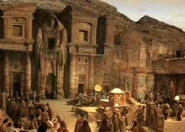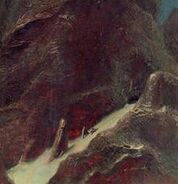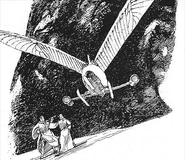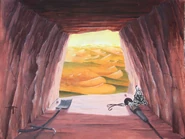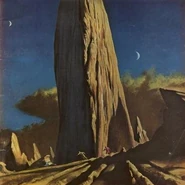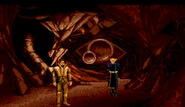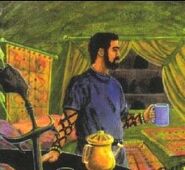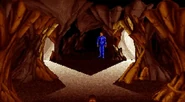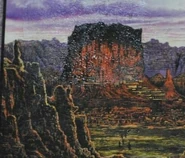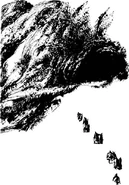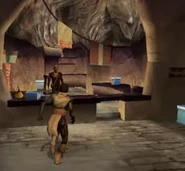
Sietch Tabr (art by John Schoenherr)
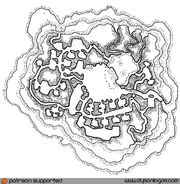
Sietch -map by dysonlogos.com
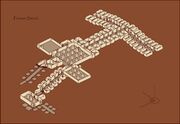
Sietch Tabr -by Topsimages
- "The sietch at the desert rim was Liet's, was Kynes's, was Stilgar's, was Muad'Dib's, and, once more, was Stilgar's. The Naibs one by one sleep in the sand, but the sietch endures."
- ―from a Fremen song[src]
The term Sietch was the Fremen term for a community or village.
Location[]
A sietch was typically located within the mountains or rock outcrops that were scattered throughout the deserts of Arrakis, hidden from the harsh sun Canopus. It was located within either a man-made or a naturally carved cave system, or occasionally a combination of both.
The actual size of the mountains and rock outcrops had to be quite large as was the network of tunnels and caves. It had to be capable of not only housing the hundreds or even thousands Fremen families, but also large enough to house all the internal economies and industries, basically a small city and all the civic necessities that would be needed even for a minimalist society like the Fremen community. Stillsuit manufacturing, processing spice and converting it into fibrous form, small scale farming, food processing, as well as the tribe's water storage, water reclamation facilities and power supply, seem to be common to most if not all sietch communities.
Infrastructure[]
The physical infrastructure of a sietch consisted of living and ceremonial quarters. It was governed by a Naib, and was constantly guarded, primarily from any hostile off-world humans.
Most Fremen living within a sietch would share much. However, some privacy was allowed, especially when it came to spending time with the family. As such, a Fremen and his family would usually be assigned a small number of rooms within the sietch. This was referred to as his yali. When a Fremen died, his yali typically went to his son, unless he died in the Tahaddi Challenge, in which case the yali went to the victor.
Some sietches, such as Sietch Tabr, also housed a stunted sandworm for Water of Life rituals. It would also be where the spice orgy would occur.
In practice sietches could be quite different types of settlements, a sietch would normally include Windtraps, Yalis, condensers, sietch-schools, corridors, sietch-factories, dew collectors, stillsuit shops, manufactures, field generators, animal dens, landing lips, plantings, caverns, small maker caches, warrens, watches, seals, moisture traps, entraces, shelters, fuel cells, assembly chambers, sietch gardens, catch-basins, exvaporation-proof basins, mega-basins, Watertraps, Qanats,storage basins, decoy barrages, Deathstills. Many of the more southern sietches were Palmaries or Oasises and during the time of Muad'dib's Rebellion many sietch villages were turned into "sietch-fortresses".
Etymology[]
The term Sietch originally meant "place of assembly in time of danger", (and possibly held some relevance to the word siege). Compare with the sich (Ukrainian січ), the chief fortress refuge settlement of the Ukrainian cossacks of Old Earth. However, due to the constantly threatened nature of Fremen life, the term evolved into a general term for a communal gathering.
Known Sietches[]
- Ammit
- Bight of the Cliff
- Cave of the Ridges
- Coanua Sietch
- False Sietch
- False Wall West Sietches
- Gara Rulen Sietches
- Hobars Gap
- Red Chasm Sietch
- Sietch Abbir
- Sietch of Alhen
- Sietch Alraab
- Sietch Gara Kulon
- Sietch Hagga
- Sietch Jacurutu
- Legg
- Sietch Makab
- Sietch of Morning
- Sietch Nadir
- Rajifiri
- Ramal
- Remmel
- Rifana Sietch
- Saajid
- Sandrat Sietch
- Sietch Tabr
- Sietch Tuono
- Tasmin Sink
- Tuck's Sietch
- Tuek's Sietch
- Umbu Sietch
- Windgap Sietch
- Sietch Yaracuwan
Images of Sietches[]
Behind the Scenes[]
It is worth noting the similarity between "Sietch" and "Seeq", which is one of the Arabic names of the ancient desert town of Petra, accessible only via a narrow passage. Notice the similarities in the structure, and the name.
The word appears once in the narrative of Dune: The Butlerian Jihad to describe the shelter of Naib Dhartha's tribe. However it is not mentioned in dialogue therefore it is not clear if the word indeed was spoken during the time of the Butlerian Jihad.


